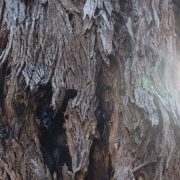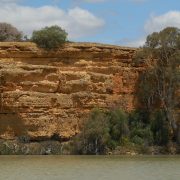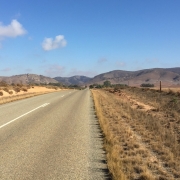The River Murray Weirs – Part 2 of 3: Eight Ways Weirs Degrade the River Ecosystem
The River Murray Weirs were constructed 100 years ago for riverboat navigation and to supply water to inland communities. But the weirs have also degraded wetlands, salinised floodplains and devastated native fish populations.
In this second article I describe the impacts of the weirs on the river ecosystem. The final article in this series will describe ecological mitigation and how weirs are being managed for the environment.
How Weirs Work
A weir is a bank built across a river to raise the water level.
Weirs don’t reduce flow: they just create a storage pool upstream. Once the pool is full, water spills over the weir and continues downstream.
The River Murray weirs were designed to support irrigation and navigation, so the pools are kept as stable as possible. Gates in the weirs are opened or closed as flow increases or decreases so that the level in the pool doesn’t change.
The fall across a weir depends on flow. At very low flows a weir pool will be flat and extend to the foot of the next weir upstream (Figure A). Water velocity will be very slow in the weir pool and higher in the tailwater. At higher flows water spilling over the weir raises the downstream level and the river develops a slope (Figure B). The slow-moving weir pool contracts. At very high flows the downstream and upstream levels equalise and the weir is flooded (Figure C).
There are thirteen weirs on the River Murray between Blanchetown and Echuca, and one further diversion weir at Yarrawonga. There are many more weirs on the tributaries.
Eight Ways Weirs Degrade the River Ecosystem
1. Migrating Fish
Golden Perch is a migratory fish species. In winter and spring the fish swim upstream over hundreds or thousands of kilometres to spawn. In upstream reaches, Golden Perch release eggs in response to flood flows. The eggs drift downstream on the floodwater, hatching along the way and drifting into nursery habitats like wetlands.
The weirs are an insurmountable barrier to fish. By blocking their upstream breeding migrations, weirs have played a major role in the decline of Golden Perch, Silver Perch and other migratory fish.
Golden Perch. Fishways now help fish navigate the weirs. Photo Lance Lloyd.
2. Fragmented Habitat
Even if they don’t migrate, aquatic animals need to move around the river.
Species like turtles, Murray Cod, Australian Smelt and Bony Herring move up and down the river to breed, to search for food and colonise new areas.
The movement of these animals is blocked by weirs. The weirs have segmented the Lower Murray into eleven sections, the shortest only twenty nine kilometres long. The weirs reduce the size of breeding populations, reduces access to habitat and makes populations more vulnerable to local threats.
3. Salt
Saline groundwater occurs naturally beneath the Lower Murray floodplain and is widespread upstream of Locks 4, 5 and 6.
When the weirs raised the river level they also brought groundwater closer to the surface. In many areas the roots of floodplain trees – Black Box and Red Gum – were exposed to salt and became sick or died. Groundwater began to seep into wetland depressions. Freshwater plants were replaced by samphire or, in the worst cases, by a crust of salt.
Lower Pike Floodplain at Lyrup, upstream of Lock 4
4. Slow Flow
Weirs have changed the Lower Murray from a flowing river to a series of lakes. The weirs have made the river broad, deep and very, very slow.
Turbulent, flowing water (faster than 0.3 m/s) is essential to Murray Cod, Trout Cod, River Mussel and Murray Crayfish. All of these species are now either extinct or very rare in the Lower Murray.
Turbulent water, flowing through snags, is ideal habitat for Murray Cod and Trout Cod. These conditions are virtually absent from the Lower Murray.
5. Drowned Wetlands
When the weirs were built they raised the river level and drowned low-lying areas. Thousands of wetlands became permanently flooded.
These wetlands used to be flooded seasonally and supported dense beds of wetland plants. The wetlands were breeding sites for fish and waterbirds and contributed to the river food web.
Permanent flooding changed the wetlands into broad expanses of open water. The wetlands are now much less productive and provide poor habitat for fish and birds.
Morgan Wetland, which was drowned by Lock 1.
6. Willows
Willows like the stable water levels provided by weirs and have become a widespread pest plant on the Lower Murray. They crowd the river bank, excluding native trees and reeds, and provide poorer habitat for native fish and birds.
Willows at Morgan, upstream of Lock 1 (@photosbyharriet)
7. Biofilms
Biofilms are the slime of bacteria, fungi and algae that grow on flooded logs and branches. Biofilms are a major food source for snails, small fish and shrimp, which become food for larger animals.
Biofilms are most productive when they are alternately flooded and dried, which happens when river levels rise and fall. Weirs have stabilised river levels, so snags are either flooded or dry most of the time. As a result, an important component of the river food web has been compromised.
Biofilms grow on flooded rocks, snags, twigs and leaves
8. Acid Sulfate Soils
Weirs have created acid sulfate soil risks by waterlogging floodplain soils.
Floodplains soils are often rich in sulfur minerals. When they are waterlogged and become anoxic the sulfur minerals can be reduced to sulfides. If these soils are exposed to the air again, the sulfides are oxidised into sulfuric acid.
The acid is toxic in its own right, but it also liberates poisonous heavy metals from the sediment. Acid sulfate soils can kill fish and plants and make water unsafe to drink.
Acid sulfate soils are safe while they remain flooded. The risk develops when weirs are lowered or when river flows are very low, which occurred in the Millennium Drought (1997-2011).
Catfish Lagoon at Merbein Common, upstream of Lock 10, has potential for soil acidification.
Conclusion
The weirs have made the river less productive and less hospitable to native plants and animals. But few of these impacts can be blamed on weirs alone. Most are made worse by other things, for example:
- irrigation drainage increases groundwater and salinity threats;
- water diversions and flow regulation intensify river stability; and
- carp reduce plant cover in drowned wetlands.
The final article in this series will describe how weirs are now being operated to reduce these threats and improve environmental outcomes.
See Also
The River Murray Weirs Part 1 of 3: Why so many Weirs?
Sources and Further Reading
MDBA (2011). Acid Sulfate Soils in the Murray-Darling Basin. Murray-Darling Basin Authority, Canberra.
MDBC (2007). The Sea to Hume Dam: Restoring Fish Passage in the River Murray. Murray-Darling Basin Commission, Canberra.
Walker, K.F. (2006). Serial weirs, cumulative effects: the Lower River Murray, Australia. Chapter 9 in Kingsford, R. (Ed.) Ecology of Desert Rivers, Cambridge University Press, Cambridge.
Thanks to Lance Lloyd for comments on the text.












